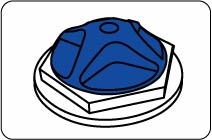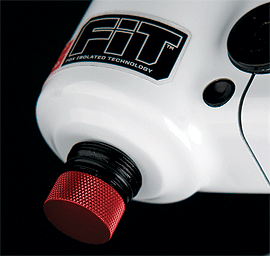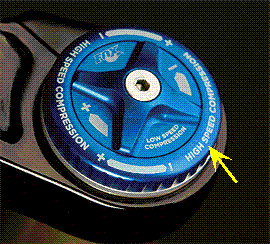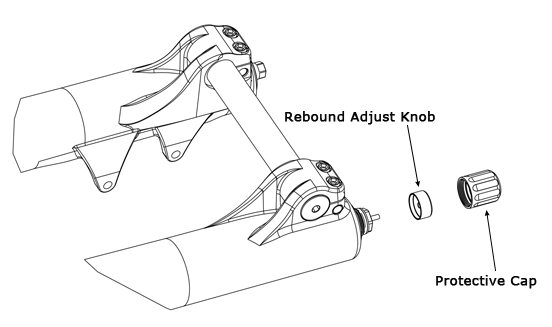




|

|

|

|
Installing Your Fork | Before You Ride | Setting Sag | Adjusting Rebound | Adjusting High-Speed Compression | Adjusting Low-Speed Compression | Changing the Coil Spring | Changing Travel | Changing Oil | Service Intervals | Important Safety Information
|
|
travel |
|
|
model features, adjustments |
Factory FIT RC2, 203: Kashima coated upper tubes, 1 1/8" steerer, low-speed compression, high-speed compression, hydraulic bottom-out resistance in damper, coil spring preload, rebound. Internally adjustable in ½-inch increments, down to 6.5 in./165 mm. |
|
|
lower leg |
20QR thru axle system, international standard disc brake tabs |
|
|
spring |
titanium coil |
|
|
riding style |
DH |
Be sure your fork is properly installed before proceeding. If your fork came pre-installed on your bicycle, continue to the next section.
NOTE: Do not use any solvents or de-greasers, as these products can cause serious damage to paint and anodized parts (upper tubes, knobs, steerers).
Do not spray water directly on the seal/upper tube junction. Do not use a high pressure washer on your fork.
You can also view a Flash video on Setting Sag.
To get the best performance from your fork, it is necessary to set and adjust sag. Generally, sag should be set to 15 – 25% of total fork travel.

FOX Part # | Spring Rate ±8% | Color Code | Rider Weight (lbs.) |
039-05-070 | 30 lb/in | Black | <90 – 120 |
039-05-071 | 35 lb/in | Purple | 120 – 150 |
039-05-072 | 40 lb/in | Blue | 150 –180 |
039-05-073 | 45 lb/in | Green | 180 – 210 |
039-05-074 | 50 lb/in | Yellow | 210 – ≥240 |
039-05-075 | 55 lb/in | Orange | 210 – ≥240 |
039-05-076 | 63 lb/in | Red | 210 – ≥240 |
FOX Part # | Spring Rate ±8% | Color Code | Rider Weight (lbs.) |
039-05-060 | 30 lb/in | Black | <90 – 120 |
039-05-061 | 35 lb/in | Purple | 120 – 150 |
039-05-062 | 40 lb/in | Blue | 150 –180 |
039-05-063 | 45 lb/in | Green | 180 – 210 |
039-05-064 | 50 lb/in | Yellow | 210 – ≥240 |
039-05-065 | 55 lb/in | Orange | 210 – ≥240 |
039-05-066 | 60 lb/in | Red | 210 – ≥240 |
Travel | 15 - 25% Sag |
6" (152 mm) | 0.9 - 1.5" (23 - 38 mm) |
6.5" (165 mm) | 1.0 - 1.6" (25 - 41 mm) |
7" (178 mm) | 1.1 - 1.8" (27 - 45 mm) |
7.5" (191 mm) | 1.1 - 1.9" (29 - 48 mm) |
8" (203 mm) | 1.2 - 2.0" (30 - 51 mm) |
Symptom | Remedy |
Too much sag | Change to higher rate coil spring |
Too little sag | Change to lower rate coil spring |
Excessive bottoming | Change to higher rate coil spring |
Harsh ride; full travel not utilized | Change to lower rate coil spring |

The red rebound knob is located on the bottom of the right fork leg, and has 18 clicks of adjustment. Rebound controls the speed at which the fork extends after compressing. Turning the knob clockwise slows down rebound; turning the knob counter-clockwise speeds up rebound. As a starting point, turn the rebound adjuster knob all the way clockwise (full in) until it stops, then turn counter-clockwise (out) 9 clicks.
The rebound knob is protected by a black protective cap. Never ride your FOX 40 without having this protective cap installed.
|
Knob Setting |
Setting Description |
Tuning Tips |
Setup Tips |
|
|
Slow Rebound |
Too slow and your fork will pack down and ride harsh. |
If you increase your spring rate, you will need to slow down your rebound |
|
9 (Factory setting) |
Average Rebound |
|
|
|
|
Fast Rebound |
Too fast and you will experience poor traction and wheel hop. |
If you decrease your spring rate, you will need to speed up your rebound setting. |

High-speed compression damping controls the force it takes to move the fork through its travel and how the wheel reacts to a bump. This adjuster rotates to stops at each end and has 24 clicks of adjustment. It is set from the factory at 12 clicks out from the fully closed (clockwise) position.
|
Knob Setting |
Setting Description |
Tuning Tips |
|
|
Soft Compression |
Maximum wheel traction and bump compliance. If setting is too soft, you may bottom often on square-edged hits and G-outs. |
|
12 (Factory setting) |
Average Compression |
|
|
|
Firm Compression |
Reduces bottom-out and provides maximum bump absorption. If setting is too firm, you may experience a harsh ride with bad traction and use too little available travel. |

Low-speed compression damping controls the influence of the rider’s weight shifts and bike attitude under braking. This adjuster rotates to stops at each end and has 24 clicks of adjustment. It is set from the factory at 12 clicks out from the fully closed (clockwise) position.
|
Knob Setting |
Setting Description |
Tuning Tips |
|
|
Soft Compression |
Maximum wheel traction and bump compliance. Too soft and you maybe have excessive brake dive and a wallowy feel. |
|
12 (Factory setting) |
Average Compression |
|
|
|
Firm Compression |
Resists brake dive and keeps the fork up in the travel. Too firm and you may have poor traction in loose conditions. |
Travel on the 40 can be changed in 1/2” increments, by rearranging the three internal travel spacers inside the left leg of the fork. With the proper tools and oil, changing the travel can be achieved in about 15 minutes.
The following tools and supplies will be needed: A 32 mm (1.25") 6-point socket, 10 mm open end wrench or socket, torque wrench, plastic hammer, oil drain pan, clean dry lint-free towels, measuring container, as well as the following:
|
Quantity |
Part Number |
Part Name |
|
1 |
025-02-003 |
1 qt. bottle of FOX Suspension Fluid (10 wt.) |
Travel Setting | # of Spacers Under Topcap | # of Spacers on Plunger Shaft |
8.0" (203 mm) | 3 | 0 |
7.5" (190 mm) | 2 | 1 |
7.0" (178 mm) | 1 | 2 |
6.5" (165 mm) | 0 | 3 |

The following tools and supplies will be needed: A 32 mm (1.25") 6-point socket, 10 mm open end wrench or socket, 15 mm deep 6-point socket, torque wrench, 2 mm hex key wrench, plastic hammer, small screwdriver, oil drain pan, clean dry lint-free towels, as well as the following:
|
Quantity |
Part Number |
Part Name |
|
1 |
025-02-003 |
1 qt. bottle of FOX Suspension Fluid (10 wt.) |
|
1 |
241-01-002-C |
8 mm Crush washer |
|
1 |
241-01-011 |
13 mm Crush Washer |
An oil change with the FOX 40 RC2 fork consists of changing the lower leg oil bath in each leg. This oil bath service can be performed with the common tools listed above, and the fork does not have to be removed from the bicycle. This service will not require any disassembly of the closed RC2 cartridge.
CAUTION: Do not attempt to disassemble the FOX 40 RC2 closed cartridge system. Only FOX Racing Shox or an Authorized Service Center should perform such a procedure.

Bushing Technology & Inspection | Control Direction | Oil Volumes | Structural Inspection | Dropout Thickness Inspection | Torque Values | Unit Conversion | Suspension Tuning Tips | Using the Pump | Important Safety Information | Service Intervals | Contact FOX Service | Warranty Information | FOXHelp Service Web Site
Copyright © 2011
FOX Factory Inc.